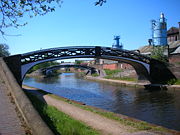
Smethwick Junction (canal)
Encyclopedia

Junction (canal)
A canal junction is a place at which two or more canal routes converge or diverge. This implies a physical connection between the beds of the two canals as opposed to them crossing on different levels eg via an aqueduct....
where the BCN Main Line
BCN Main Line
The BCN Main Line, or Birmingham Canal Navigations Main Line describes the evolving route of the Birmingham Canal between Birmingham and Wolverhampton in England....
Canal from Birmingham
Birmingham
Birmingham is a city and metropolitan borough in the West Midlands of England. It is the most populous British city outside the capital London, with a population of 1,036,900 , and lies at the heart of the West Midlands conurbation, the second most populous urban area in the United Kingdom with a...
splits into the BCN Old Main Line and the BCN New Main Line near to Smethwick
Smethwick
Smethwick is a town in the Metropolitan Borough of Sandwell, in the West Midlands of England. It is situated on the edge of the city of Birmingham, within the historic boundaries of Staffordshire, Worcestershire and Warwickshire....
, West Midlands
West Midlands (county)
The West Midlands is a metropolitan county in western central England with a 2009 estimated population of 2,638,700. It came into existence as a metropolitan county in 1974 after the passage of the Local Government Act 1972, formed from parts of Staffordshire, Worcestershire and Warwickshire. The...
, England
England
England is a country that is part of the United Kingdom. It shares land borders with Scotland to the north and Wales to the west; the Irish Sea is to the north west, the Celtic Sea to the south west, with the North Sea to the east and the English Channel to the south separating it from continental...
.
Smethwick Junction has two Horseley Ironworks
Horseley Ironworks
The Horseley Ironworks was a major ironworks in the Tipton area in the county of Staffordshire, now the West Midlands, England....
roving bridge
Roving bridge
A roving bridge, changeline bridge or turnover bridge is a bridge over a canal constructed to allow a horse towing a boat to cross the canal when the towpath changes sides...
s dated 1828. They were built as part of Thomas Telford
Thomas Telford
Thomas Telford FRS, FRSE was a Scottish civil engineer, architect and stonemason, and a noted road, bridge and canal builder.-Early career:...
's improvements to the Birmingham Canal. Each bridge has a span of 52 feet 6 inches and the arch rises nine feet. The semi-elliptical form gives greater headroom above the towpaths. The ribs were manufactured in two parts and are bolted at the crown. They have an X-lattice structure with a decorative quatrefoil pattern below the handrail. The deck is of cast-iron plates with raised ribs 2½ inches high cast on their upper surfaces to help retain the earth filling which forms the footway. The bridge abutments and wing walls are of brick with stone facings at the corners. There are deep cuts in the ironwork of the bridges caused by the abrasion of tow-ropes.
See also
- Canals of the United KingdomCanals of the United KingdomThe canals of the United Kingdom are a major part of the network of inland waterways in the United Kingdom. They have a colourful history, from use for irrigation and transport, through becoming the focus of the Industrial Revolution, to today's role for recreational boating...
- History of the British canal systemHistory of the British canal systemThe British canal system of water transport played a vital role in the United Kingdom's Industrial Revolution at a time when roads were only just emerging from the medieval mud and long trains of pack horses were the only means of "mass" transit by road of raw materials and finished products The...

